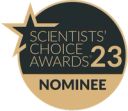Collagen Type I, Rat Tail
ibidi GmbHUse this high-quality rat tail collagen type I solution for cell culture applications (e.g., 3D gels, scaffolds, and coating).
Cell adhesion assays are used to quantitate attachment and analyze the molecular mechanisms for extracellular matrix adhesion, cell migration and sensitivity to inhibitors. Find the best cell adhesion assay equipment in our peer-reviewed product directory: compare products, check customer reviews and receive pricing direct from manufacturers.
Use this high-quality rat tail collagen type I solution for cell culture applications (e.g., 3D gels, scaffolds, and coating).
Use this slide to investigate angiogenesis in tube formation assays. Also ideal for 3D cell culture and immunofluorescence staining. Also available in a 96 well format.
Decellularized extracellular matrix (dECM) hydrogels for 2D and 3D cell culture applications.
Ready-to-use, 96-well black-walled glass-bottom microplates containing precast synthetic hydrogels designed to easily establish 3D cell cultures by direct seeding of cells.
Combining the sensitivity of a fluorescence-based assay with a microplate format enables a rapid, quantitative readout suitable for high-throughput analysis. In a microplate well, the fluorescent signal can be generated within whole cells, in cell lysates, or in purified enzyme preparations and may then be analyzed by measuring fluorescence intensity from the well without the need for cellular imaging.
The complete leak proof and gas permeable packaging solution for culturing and shipping in 24/96/384 multiwell plate formats.
An easy-to-use, modular platform to co-culture different cell types in discrete 3D and 2D compartments.
The Organoid Analysis Module for the CytoSMART Omni systems is an advanced machine-learning algorithm for robust organoid quantification, tracking, and analysis.
Scilia Extragel Matrix is a reconstituted matrix hydrogel formed by basement membrane components extracted from mouse tumor tissues which are rich in extracellular matrix proteins.
Xenium In Situ is the next-level in situ solution for subcellular profiling of 100s of RNA targets, in fresh frozen or FFPE tissue.

First IHC companion diagnostic for determining folate receptor alpha (FOLR1) protein expression in EOC patients who may benefit from ELAHERE™ (mirvetuximab soravtansine)

Quantify effector to target cell binding, phenotypic changes, and killing, all in a single label-free assay.
The cloud-based Cytobank data analysis platform is an ideal solution for immunologists and cytometrists who need to quickly gain insights from large datasets while having confidence in their results, reducing subjectivity of their analysis and eliminating error-prone and time-consuming steps.
AbZelect™ and AbZelectPRO™ support cell line development (CLD) to rapidly progress therapeutic protein and recombinant vaccine projects while de-risking the journey to Investigational New Drug (IND) application.
EpiScreen® – an extensive suite of bioinformatic and primary human cell-based assays for immunogenicity assessment to inform of potential safety and efficacy risks in the clinic.
SCAPOVA™ is the brand name of PVA microcarriers that is manufactured by Kuraray. SCAPOVA™ CL has a collagen coated surface. SCAPOVA™ CL has higher cell proliferation than competitors. And due to the robustness of PVA, SCAPOVA™ CL is less likely to break, and there is little contamination during cell collection. All microcarriers are gamma irradiated.
SCAPOVA™ is the brand name of PVA microcarriers that is manufactured by Kuraray. SCAPOVA™ CL has a collagen coated surface. SCAPOVA™ CL has higher cell proliferation than competitors. And due to the robustness of PVA, SCAPOVA™ CL is less likely to break, and there is little contamination during cell collection. All microcarriers are gamma irradiated.
SCAPOVA™ is the brand name of PVA microcarriers that is manufactured by Kuraray. SCAPOVA™ CL has a collagen coated surface. SCAPOVA™ CL has higher cell proliferation than competitors. And due to the robustness of PVA, SCAPOVA™ CL is less likely to break, and there is little contamination during cell collection. All microcarriers are gamma irradiated.